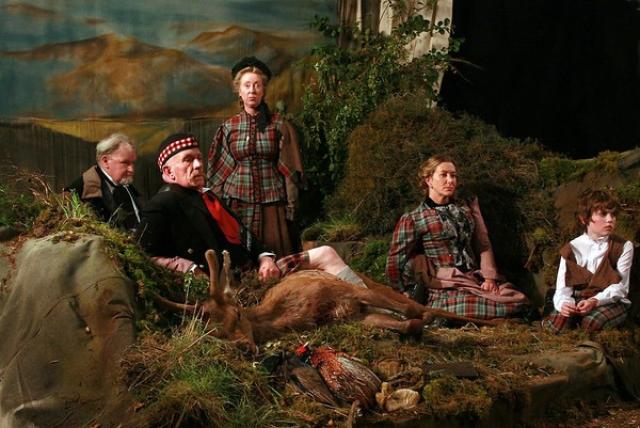Sir Edwin Landseer's iconic painting, The Monarch of the Glen, has returned to the Scottish National Gallery in Edinburgh, having been on tour across Scotland and to London. Broadcaster and artist Lachlan Goudie describes the significance of Landseer's work.
The Monarch of the Glen (about 1851) is an icon, a swirling storm of Victorian melodrama. There has never been a more potent, visual evocation of Scotland’s impact upon the popular imagination - it’s right up there with bagpipes, tartan and a mouthful of shortbread. Few other works of art are so instantly recognisable and few other canvasses have provoked such conflicting emotions in the psyche of a nation.
It was of course, the cultural tag-team of Queen Victoria and Sir Walter Scott that sparked the nineteenth century’s fascination with the Highlands. During Victoria’s reign the growing hysteria surrounding the myth and the mystery of this Northern wilderness reached its apotheosis. And it was the Queen’s favourite painter, Sir Edwin Landseer (1802-1873) - an Englishman, whose paintings populated the stage-set of Scotland with a bustling cast of Highland worthies and an even greater host of Scottish wildlife.

Copyright The Artist. Written & directed by Henry Coombes, Produced by Ciara Barry, A Brocken Spectre production.
The Monarch of the Glen depicts a stag emerging from the heather, wreathed in Highland mist. Virtually from the day it was completed it became and continues to be, one of the most reproduced visual icons in history, it has spawned countless imitations – prints, engravings, advertisements, beermats, biscuit tins. You’ve probably got a bottle of whisky in a cupboard somewhere, sporting its outline. The painting still inspires contemporary artists from Peter Blake to Peter Saville and Henry Coombes, who have appropriated the image within a new post-modern context.
Landseer’s paintings, however, are sometimes hard to stomach for a contemporary audience. Some people interpret this image as an example of cultural colonialism - a myth imposed by an Englishman intended to obscure a more authentic national identity. Worse than the painting’s ubiquity is our historical awareness that the stag and stag hunting were key culprits in the tragedy of the Highland Clearances. It’s symbolic of a culture that prioritises rich men’s sports over poor men’s lives.
But in my eyes, these issues make it even more important that this painting remains in Scotland as part of our national collection. This is not merely a superficial image, it’s a painting that has been layered with significance and meaning; a complex backstory that is part of our DNA and cannot simply be airbrushed from Scotland’s past.
What is often overlooked, when distracted by the politics and popular associations of this image, is that Landseer’s painting is also technically brilliant. Within the genre of animal painting he has never been surpassed. His ability to spirit up the physicality, the presence and even the character of any given animal marks him out as a virtuoso. Painting with this skill and subtlety is not easy. But more than this, The Monarch of the Glen is a powerfully composed and structured painting. It’s an image that has been intricately designed to both seduce and dominate its viewer. We’re drawn ever closer, just as we might be in nature, towards an animal that combines great beauty with the power to turn on us at any moment.

Edwin Landseer was an exquisite draughtsman, a child prodigy whose own life was grimly coloured by melancholy, nervous breakdown and addiction to alcohol and drugs. At the end of his life his family had him declared insane. On canvas, however he was entirely coherent.
The Monarch of the Glen is the kind of cinematic image that has turned the idea of Scotland into a blockbuster. Any country in the world would kill for the kind of instantly identifiable imagery that Scotland has inherited in spades.
There’s no doubt that a great deal of nineteenth-century Scottish art is predicated on a myth. The landscape of Scotland was, in reality, a place of great hardship where people’s lives were sometimes treated like commodities. But myths, lies and propaganda have been part of Scottish art for centuries and we continue to be complicit in projecting a certain image of our nation. Just consider the ‘Visit Scotland’ tourism campaigns.
The Monarch is loved and loathed. For many people it’s the equivalent of that elderly family relative who comes to stay and insists that you all watch the reruns of Scotch and Wry; tolerated and humoured but you just can’t wait to get them off the couch so you can change the channel.
However, it’s time to wake up and smell the heather. Behind the bombast our sense of identity as Scots is a fragile thing. We must embrace all the traits that make us who we are and this painting vividly represents many aspects of our character. The Monarch of the Glen belongs in Scotland, it’s part of the family and should be hung not in a boardroom or a palace but in the home of our national art collection, The National Galleries of Scotland.
In 2017 the painting embarked on a nationwide tour of Scotland. It was on loan to four venues across the country, giving the public a chance to see and interact with it. In this film, staff from the National Galleries of Scotland, Inverness Museum and Art Gallery (the first venue on the tour), and artists Ross Sinclair and Allan Whyte discuss the painting and its national significance.

In this illustrated talk, Dr Jonathan Murray of the Edinburgh College of Art considers both the historical roots and the enduring cultural resonance of Landseer’s work.






